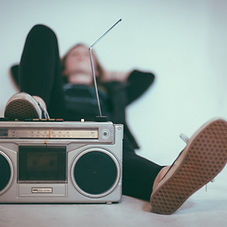
EarSketch Amazon Virtual Kids Week Challenge
2020, Sponsored by Amazon Future Engineer
In collaboration with Amazon Future Engineer, EarSketch hosted the Amazon Virtual Kids Week Challenge and invited students to create the next Song of the Summer by remixing music using computer science! Remix tracks from award-winning artists, Ciara and Common, by coding in Python or JavaScript.


Jump to section:
Results
Top Winners
Top Winner
Arnaldo L.
Grade 10
Teacher: R. Williams
Collins Hill HS
Suwanee, GA
Requirements
Music
-
Song should be recognizable as a "summer song" (see resources for musical elements of a summer song)
-
Song must include at least one uploaded sound or recording that should support the message you want to convey with your song
-
Song must be at least 16 measures long
-
Song must have at least 3 tracks
Code
-
Code must include the use of setEffect()
-
Code must have at least one for-loop
-
Code must include variables
-
Code must include comments to structure your code
Submission
-
Submission must be through SoundCloud and through the submission form
Competition Themes
Choose from any of the 3 Song of the Summer categories below:

Theme 1: Breaking a Sweat on a Run

Theme 2: Jamming out to a Summer Anthem

Theme 3: Relaxing with your Code
Theme 1: Breaking a Sweat on a Run
Description
-
Workouts and music go together like cake and ice cream!
-
Research shows that listening to high-tempo music while exercising results in the higher heart rates and lower perceived exertion compared with not listening to music
-
In other words, people got a more efficient workout, while feeling that the workout was less strenuous.
-
Characteristics
-
Tempo
-
Depends on the workout
-
For your warm-up, choose songs that have a lower BPM (80 BPM). Make sure they're songs that perk up your energy for the workout ahead.
-
A song with faster beats per minute should accompany a higher-intensity portion of your workout.
-
High-tempo music (approximately 170 heartbeats per minute) reduces perceived effort and boosts cardiovascular benefits more than lower tempos.
-
-
The music tempo used for weightlifting will be much slower than running (approximately 80 to 115 BPM).
-
A 2011 study revealed that in order to achieve the best performance for cycling (calculated by measuring exercise intensity through heart rate), and the preferred tempo is between 125 to 140 BPM.
-
A 2014 study revealed that the best music tempo for enhanced performance on the treadmill is between 123 and 131 BPM.
-
-
"Music tempo should be selected with the expected exercise intensity in mind, and be sequenced to contour in accordance with changes in heart rate" [2]. Gradually increasing the BPM as your heart rate increases will help you stay motivated, even if you're not using music synchronously.
-
-
Instrumentation
-
A strong, steady beat
-
A strong, energizing rhythm, uplifting melodies, and inspirational lyrics
-
A strong, energizing rhythm
-
In order for a song to be properly motivated, it needs to be "up-tempo (>120 BPM) and possess prominent percussive and rhythmical features" [3].
-
-
Mood-boosting melody and lyrics
-
Making you feel good about yourself is one of the ways music is most helpful during a workout, which is why you should choose tunes that promote "motivational imagery and self-talk." Songs that feature "affirmations of exercise or inspirational references drawn from popular culture" are particularly effective. Think "Shake it Off" by Taylor Swift or "Don't Stop Me Now" by Queen.
-
-
-
Theme 2: Jamming out to a Summer Anthem
Description
-
To have a hit song simply means to have a song that is "widely popular"
-
Tough to pin down, there's an entire science dedicated to it!
-
"Hit Song Science" [4]
-
Characteristics
-
Tempo
-
Not necessarily restrained to a tempo range. More about connecting with the widest range of people possible.
-
-
Recommendations
-
Select a theme. Use universal themes and emotions so that anyone can connect with your song.
-
Happiness
-
Sadness
-
Love
-
Excitement
-
Memorable Events
-
-
Write timeless lyrics. Timeless lyrics will still be enjoyed even after a considerable time has passed. These lyrics are relatable to a wide audience, which improves overall popularity with many different age groups.
-
Often avoiding "fadish" themes
-
-
Look for lyrical inspiration in poetry, art, and the natural world.
-
The melody of your song should complement and synchronize with the beat of the metronome and bass-line.
-
Instruments frequently used for the melody include:
-
Piano
-
Guitar
-
Brass (like the trumpet or trombone)
-
Organ
-
Synth tones
-
etc.
-
-
Design your melody with a "rise" and "fall" of tone throughout the melody. Changes in volume and energy will make the song interesting to listeners.
-
-
-
Dance-ability
-
People love to dance and have fun. Try incorporating instruments and rhythms that encourage listeners to get up and dance!
-
Theme 3: Relaxing with your Code
Description
-
"Chill-out" music
-
"Lean back listening," which refers to a listener who, "thinks less about the artist or album they are seeking out, and instead connects with emotions, moods, and activities" [5].
-
"Chill-out" typically has slow-rhythms, sampling, a "trance-like nature," and a mixture of electronic instruments with acoustic instruments.
Characteristics
-
Tempo
-
"It could be said that as long as the tempo remains below 120 BPM and it employs a laid-back groove, it could be classed as chill out" [6]
-
Generally between 90-120 BPM.
-
-
Instrumentation
-
"Chill-out" typically has slow rhythms
-
A mixture of electronic instruments with acoustic instruments
-
Reverb is your friend! It creates great texture and space in the track.
-
Keep it minimal and sparse. You don't want too much noise or sounds clashing against each other for attention. That kills the vibe.
-
For drums, we recommend a consistent groove, like something that you can really take into your mind as a cohesive production. If you make it too overbearing, the listener will get caught up trying to follow all the details.
-
Piano is always great for "chilled-out" vibes. Rhodes or a Wurlitzer with tasteful panning can do amazing things.
-
Delay is another great effect to experiment with to give sounds more character and space, but too much can cause chaos.
-
References
[1] Snoman, Rick (2013). Dance Music Manual: Tools, Toys, and Techniques. Taylor & Francis. pp. 88, 340–342. ISBN 978-1136115745. Retrieved 17 May 2014.
[2] Karageorghis, C. I., & Priest, D. L. (2011). Music in the exercise domain: a review and synthesis (Part II). International Review of Sport and Exercise Psychology, 5(1), 67–84. https://doi.org/10.1080/1750984X.2011.631027
[3] Dunlap, K. (2015, January 21). How to Create the Perfect Workout Playlist (According to Science). BuzzFeed. https://www.buzzfeed.com/kelleydunlap/how-to-create-a-workout-playlist-according-to-science
[4] Seufitelli, D. B., Oliveira, G. P., Silva, M. O., Scofield, C., & Moro, M. M. (2023). Hit song science: a comprehensive survey and research directions. Journal of New Music Research, 52(1), 41–72. https://doi.org/10.1080/09298215.2023.2282999
[5] Jackson, A. (2024, June 24). In the Mood for “Fake” Music? JSTOR DAILY. https://daily.jstor.org/in-the-mood-for-fake-music/
[6] Snoman, Rick (2013). Dance Music Manual: Tools, Toys, and Techniques. Taylor & Francis. pp. 331. ISBN 978-1136115745. Retrieved 17 May 2014.
Artists

Ciara
About

About Text

Common
About
About Text